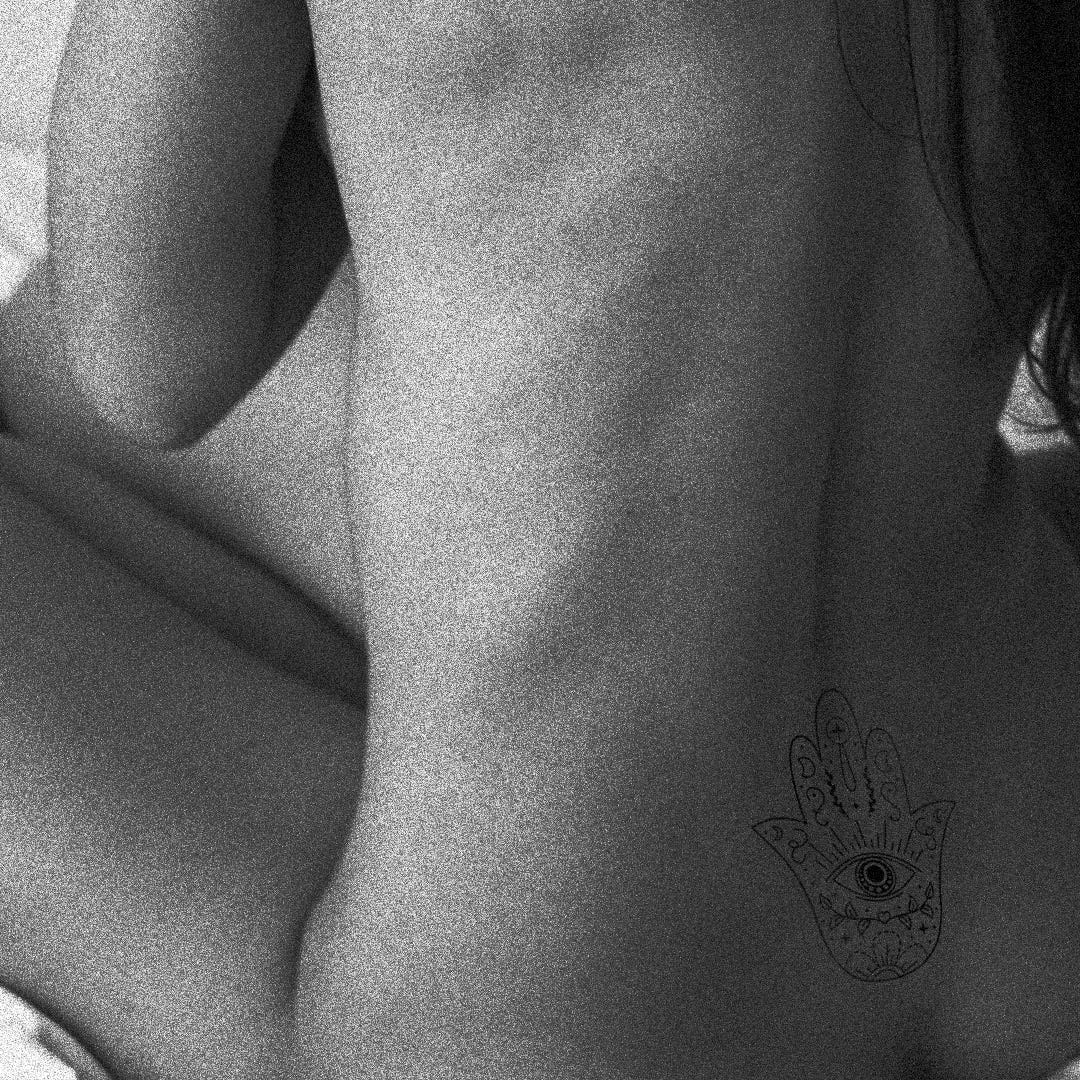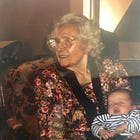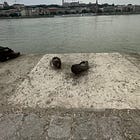Tattoo Jew
In my 20s, I got a tattoo to link myself to my grandmother and her Auschwitz tattoo. When I tried to remove it in my 40s, I realized it was too late. The ink had already left its mark on my son.
“You are going to feel a little pinch,” says the nurse.
My hands squeeze the corners of the bed at the medical spa, where I lay on my stomach, my pants pulled down to the crack of my butt. Any concerns over dignity faded a long time ago, faster than this old tattoo I got in the 1990s, back when getting one, like piercing your nose, still marked you as different. It’s my seventh removal treatment, so the black lines are now faded or blurred, especially near the bottom, but you can still make out the hand of a hamsa -- two thumbs on either side of three fingers, with an eye in the palm, a symbol meant to ward off evil.
The nurse squeezes my skin and whispers “pinch” as the first of several, tiny needles enter my lower back. The tattoo is on the smaller side, so the entire procedure will take less than 15 minutes. Still, I psych myself up for the pain like a runner does for a marathon. At least the pain helps me to drown out my internal monologue, chastising me for a youthful indiscretion everyone said would come back to haunt me.
“It’s against Halacha to permanently mark your skin,” the naysayers warned me, using the Hebrew word for Jewish law. Pinch. “You won’t be able to be buried in a Jewish cemetery.” Pinch. “What would your grandmother think?” Pinch.
“We’re almost done with the worst part,” the nurse says, referring to the freezing but I’m not sure she’s right as she readies the high intensity beam that breaks down the pigments that have remained under my skin longer than I’ve known most my friends, had children or owned any of my dogs.
The zapping starts, and tiny, electrified daggers begin stabbing me in succession with a snapping that sounds like a lighter struggling to get lit. I smoked back then and would have finished a cigarette before garnering the courage to enter the tattoo parlour on Queen Street. I hold my breath during the pain and conjure up the store in my mind, how I looked at 23 when I walked in and asked with the bravado that dissipates as you get older, “do you know what a hamsa looks like?”
Before I can finish imagining the scene, I hear the nurse say, “you’re done,” and move the machine away. Only ten minutes. We’ve finished in record time. I quickly calculate that I’ve spent over $5,000 on these procedures, which only adds to the pain. “Give it a few more months before the next one,” the nurse says. “So, your body has time to absorb the ink.”
I nod as I pull up my sweatpants over the bandages, but I’m careless as I do so and it stings. When I get home, the journalist in me wonders how it’s possible that the body doesn’t absorb the ink on its own over time. A quick Google search brings me an article explaining that the immune system produces cells called macrophages that eat the ink, and then pass it on to their replacements when they die. Thus, the tattoo pigment particles are transmitted without any of it vanishing.
L’dor v’dor—passed along, from generation to generation, as the Hebrew saying goes. Ink getting reborn in each generation.
I grew up in the shadow of my grandmother’s tattoo. Tiny numbers, A-6545, in bluish ink sit high up on the inside of her left forearm, marking her as one of thousands of Hungarian Jews branded on their arrival to Auschwitz in 1944.
As an Orthodox Jewish woman, she almost always wore long sleeves, but I’d steal glances when she pushed them up to cook or wash dishes. I still remember how precisely the lines of the numbers looked, as if written by a child eager to please. As soon as I was old enough to ask, she explained it was a friend’s phone number she kept forgetting. But even as a four-year-old I knew phone numbers had seven digits and as an Orthodox woman, she would never write on her skin, even with ink.
So, her lie scared me. It hinted at something terrible. Which may be partly why, as early as five, my bad dreams began. I’d wake up and tell her about the ferocious dogs lunging at me from behind a fence. Or I’d see smoke coming up from the buildings in the distance. Or I could hear the clattering noise of trains on tracks. It was only years later that I learned my grandmother had been forced to sort through and clean the clothes of Jews who’d been immediately killed on arrival to the camp.
With her old country superstitions still intact, my grandmother did her best to protect me. I was her gift, she often told me. She talked about the evil spirits that lurked just under the surface, tying red strings around my wrists and neck and chanting unknown prayers as she dabbed my face with bread dipped in blessed water.
And yet she couldn’t stop the transmission. I inherited her story the same way I inherited the shape of her eyes. To counterbalance the bad, she taught me to always search for happiness, even in my worst moments. To this day, I consider joy to be my default setting.
My hamsa tattoo, which I loved in my 20s, began to irritate me in my 40s. The pigment was fading, and the design looked dated. Worst of all, the culture at large had long ago moved on from slackers and grunge, from Kurt and Riot Girls, and my tattoo, just above the base of my spine, was now a tramp stamp.
Why don’t you redo it, with colour, maybe?” my boyfriend Isac said.
“No,” I replied, too harshly. The tattoo was a relic of my past. I’d tried to ignore it for years and wanted everyone else to ignore it, too.
Not long after, Azriel, my son, wanted to get his ears pierced but being under the age of 16, needed parental consent. “Parental consent for an ear pierce?” I scoffed in a way only a jaded Gen X-er can. In my day, you just skipped school to go the Eaton Centre while some random lady at a kiosk stapled a hole in your earlobe and then sold you a broken heart earring you shared with your best friend.
He made an appointment at a tattoo parlour in a dingy part of downtown without any sign on the door, so I shrugged and thought, this is how teens rebel nowadays, secretly delighted. That delight faded once we stepped inside to what looked like a medical spa. “Please sign these forms,” the heavily tattooed receptionist said, handing me a clipboard. “Both sides.”
While he waited for his “post-op” instructions, it surprised me to find a room that advertised tattoo removals. I self-consciously showed the technician my tattoo, likely older than her, and made an appointment to return the next week.
A clean slate, I told myself, as the technician handed me an ice pack and told me to lay down. When she started zapping, I experienced some of the worst pain in my life. That first treatment cost me a fraction of what I’d eventually spend to get removal treatments at a real medical spa but it suddenly made my tattoo impossible to ignore.
“You may see some scabbing,” the technician had warned, handing me bandages on the way out.
I realized I was only blocks away from the tattoo parlor I’d visited at 23. Unlike the removal, getting a tattoo hadn’t hurt back then. Rather, it felt like I was on fire. A normal reaction, the artist assured me, but one that gave the whole experience a somewhat spiritual caste.
I had just returned from living in Israel and had been in the process of losing my religion. As the artist started inking, I imagined each needle to be a stake I placed in the ground, reclaiming my body and my history for myself.
My body is not on loan from God, I told myself.
I will honour my grandmother’s tattoo, but also defy it.
She didn’t have a choice; I do.
When my body began to burn, I knew I made the right decision. I had transformed myself into someone with agency over her body.
I was thrilled with how the hamsa looked back then. I was certain it would protect me, just like my grandmother’s red strings. But I never showed it to her. Part of me worried that I’d never be able to communicate in our broken English why I’d done this; and I knew I’d have offended her religious sensibilities. But my biggest fear was that she would believe that she failed to protect me.
Two years ago, Isac and I took our first holiday to the “other” Holy Land —his homeland--Jamaica.
One night, after I returned to our room, slightly intoxicated, my now 18-year-old son texted and asked if we could FaceTime. I was already in bed but willed myself to sober up for the call. “Everything is fine,” he said into the camera. My beautiful boy, I thought to myself as I stared at him. The same one my grandmother rocked in her lap.
“I have something to show you,” he said. He pulled up his sleeve.
“What am I looking at exactly?” I asked, failing to react—or even, in the moment to see, the fresh ink on his bicep.
“It’s a Tralfamadorian!” he told me excitedly. In my state, it took several moments to get the reference to the aliens in Kurt Vonnegut’s Slaughterhouse Five.
Trafamadorians live simultaneously in the past, present, and future, privy to all the secrets of the universe. Vonnegut was my teenage obsession that I carried into adulthood. His anti-war stance struck a chord in me just as my anger over my family’s history began to fester. When my son was younger, I used to boast that as a teenager, I stole a copy of Happy Birthday Wanda June from the library. It inspired him, I learned, to steal a copy of Cat’s Cradle from his school library.
Later, I’d recall that the Tralfamadorians have a hand for a face, just like my hamsa has a hand with an eye. But in the moment, I’d failed to see how my son was trying to connect with me through ink, just as I had done years before with my grandmother.
“You don’t like it?” he said.
“No, I do,” I paused. “I’m just surprised at how large it is.”
My boy is grown, was all I could think. I would never cuddle him in bed again as he slept, would never again have my gift back. He was now an adult—with the same agency I’d once craved.
“I love you,” I said. “I’m glad you are happy.”
I went to bed that night thinking of Tralfamadorians, who looked at human suffering with indifference. To Vonnegut, they stood for a perfect world, one devoid of pain, but also one devoid of free will. In that way they represent something of the terrible world my grandmother discovered during the war—one free from the choice to be tattooed, or to be a slave laborer, or a witness to genocide.
My grandmother had wanted to keep the transmission of her pain away, just as she never would’ve wanted me to be tattooed. That she couldn’t stop. Ironically, it’s through the removal of my tattoo, rather than its original inking, that I find myself closer to her than ever. And yet it’s only through my tattoo’s removal that I began to see the transmission more clearly.
Months later, after another painful removal session, I found myself in my massage therapist’s home office. I take off my clothes and slip under the sheets. I ask her to avoid the tattoo, but she knows the drill.
“If I didn’t know better, I’d say it could pass for a bruise,” she tells me.
A bruise sounds right, I think, remembering that the original tattoo came from a place of pain.
I mutter something about how I’m almost there, how it may be time to stop.
“You can’t stop now,” she says, tapping my shoulders for emphasis. “You’re so close to removing it.”
I’m not so sure. On one hand, I no longer feel the need for the hamsa’s protection. I also no longer suffer from the vanity of knowing it’s completely gone. The pain of removing it reminded me of my original intentions. I’ll always have the tattoo. So will my grandmother. So will my son. We can’t do anything to stop the transmission of ink or pain or memory. But like the Tralfamadorians, we can stop to stare at the beauty of this single moment in time.
Share the ❤️! It makes me feel good and helps others discover my work. Also, read other links in the series:









Ohmygoodness. This is gorgeous, Leah. I'm so glad I asked to read it. You're an exquisite writer. As a child I suffered because I too received transmissions. I lived in fear, as a late boomer I was close to the immediacy of memories of the Holocaust. I'm so glad your grandmother survived. I'm so sorry she had to experience something no one should ever have to experience. I have very strong associations to the Auschwitz tattoos. That's why my Hineni is on the inside of my left arm. It's a remembrance of and an act of rebellion against the memory of the monsters who treated so many beautiful souls like dirt. Seriously blown away in this moment. I definitely would like to post a link to this story when I post mine this week. Thank you for sharing it.
A wonderful piece of writing. Fascinating that you had those dreams as a child. And the way you connect it all back through the generations. Simply beautiful.